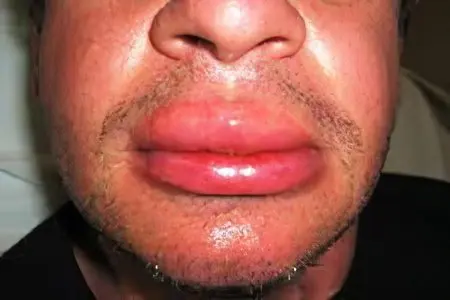Contents
What is angioedema?
Quincke’s edema is a local edema (diffuse or limited) of mucous and subcutaneous tissue, which suddenly appears and develops rapidly. The German doctor, a therapist and surgeon by profession, Heinrich Quincke, after whom the pathology is named, first discovered and described its symptoms in 1882. Quincke’s edema can also be called angioedema (or angioedema), giant urticaria. Giant urticaria occurs predominantly in young people, while in women it is more common than in men. According to statistics, the prevalence of this disorder in children has recently increased.
Giant urticaria occurs on the principle of ordinary allergies. But in this case, the vascular component is more pronounced. The development of the reaction begins with the antigen-antibody stage. Allergy mediators affect blood vessels and nerve trunks, causing disruption of their work. There is an expansion of blood vessels, an increase in their permeability. As a result, plasma penetrates into the intercellular space and local edema develops. Violation of the work of nerve cells leads to paralysis of the nerve trunks. Their depressive effect on the vessels stops. In other words, the vessels do not come into tone, which in turn contributes to an even greater relaxation of the vascular walls.
Most patients have a combination of edema and acute urticaria.
Symptoms of angioedema

Quincke’s edema is characterized by a sharp onset and rapid development (for several minutes, less often – hours).
Angioedema develops on organs and parts of the body with a developed layer of subcutaneous fat and is manifested by the following symptoms:
Swelling of the organs of the respiratory system, more often – the larynx. With swelling of the larynx, hoarseness of the voice appears, breathing becomes difficult, accompanied by a barking-type cough. The general anxiety of the patient is also observed. The skin in the facial area first acquires a blue, then a pale tint. Sometimes the pathology is accompanied by loss of consciousness.
Local swelling of various parts of the face (lips, eyelids, cheeks).
Edema of the mucous membranes of the oral cavity – tonsils, soft palate, tongue.
Edema of the urinary tract. Accompanied by signs of acute cystitis and acute urinary retention.
Edema of the brain. It is characterized by various neurological disorders. It can be various convulsive syndromes.
Edema of the digestive tract. It is characterized by signs of an “acute” abdomen. Possible dyspeptic disorders, acute abdominal pain, increased peristalsis. There may be manifestations of peritonitis.
Often, angioedema spreads to the lower lip and tongue, larynx, which leads to a deterioration in respiratory function (otherwise asphyxia). Edema on the face also threatens to spread the process to the membranes of the brain. In the absence of emergency assistance of qualified specialists in this case, a fatal outcome is possible.
Causes of angioedema

The causes of Quincke’s edema can be different:
The consequence of an allergic reaction that occurs upon contact with the allergen.
The most common allergens are:
certain foods (fish, citrus fruits, chocolate, nuts)
preservatives and dyes found in foods (often in sausages, sausages, cheeses)
plant pollen
down, bird feathers and animal hair
poison or saliva of insects that enters the human body when bitten by insects (wasps, bees, mosquitoes, mosquitoes, etc.)
household dust
The consequence of a parasitic or viral infection (giardiasis, helminthic invasions, hepatitis).
Edema of non-allergic origin (pseudo-allergic reactions), reflecting a different somatic pathology, for example, functional disorders of the digestive system.
A tendency to edema can occur in people with endocrine disorders, including the thyroid gland.
Edema caused by tumor diseases and blood diseases.
Edema that occurs under the influence of chemical (including medicines) and physical (pressure, temperature, vibration) factors. Drug allergy most often occurs on drugs of the class of analgesics, sulfa drugs, antibiotics of the penicillin group, less often – cephalosporins.
Hereditary angioedema, resulting from a congenital disorder – a deficiency of certain enzymes (C-1 inhibitors of the complementary system), which are directly involved in the destruction of substances that provoke tissue edema. This pathology is more typical for men, provoked by injuries, excessive stress on the nervous system (for example, stress), suffered by an acute illness.
Emergency care for Quincke’s edema

Quincke’s edema develops very unpredictably and poses a threat to the life of the patient. Therefore, the first thing to do is to call an ambulance, even if the condition is currently satisfactory and stable. And in no case should you panic. All actions must be quick and clear.
Before the arrival of the ambulance
It is necessary to seat the patient in a comfortable position, to calm
Limit contact with the allergen. When bitten by an insect (wasps, bees), the sting must be removed. If you cannot do this yourself, you need to wait for the arrival of specialists.
Give an antihistamine (fenkarol, diazolin, diphenhydramine). Injectable forms of antihistamines are more effective, since it is possible that edema of the gastrointestinal tract develops and the absorption of substances is impaired. In any case, it is necessary to take 1 – 2 tablets of the drug if it is not possible to give an injection. The medicine will weaken the reaction and alleviate the condition until the ambulance arrives.
Be sure to drink plenty of alkaline water (per 1000 ml of water 1 g of soda, either Narzan or Borjomi). Drinking plenty of water helps to remove the allergen from the body.
Enterosgel or ordinary activated carbon can be used as sorbents.
In order to reduce swelling and itching, a cold compress, a heating pad with cold water, and ice can be applied to the swollen area.
Provide good access to fresh air, remove objects that make it difficult to breathe.
With a severe degree of edema, it is better not to take any measures on your own, so as not to provoke a deterioration in the patient’s condition, and wait for an ambulance. The main thing is not to harm.
After the arrival of the emergency ambulance
The provision of emergency care is aimed at the implementation of several tasks.
Stopping exposure to the suspected allergen. It is necessary to avoid the progression of the disease. A cold compress has a good effect. A heating pad with cold water or ice will do. If the swelling is the result of an insect bite or drug injection, apply a tourniquet above the bite/injection site for 30 minutes.
hormone therapy. Therapy with glucocorticosteroids is necessary to eliminate edema and normalize respiratory function. For giant urticaria, prednisolone is the drug of choice. With a combination of Quincke’s edema with urticaria, dexamethasone can be used.
desensitizing therapy. Antihistamines are used to reduce the body’s sensitivity to repeated exposure to allergens. Suprastin, diphenhydramine, tavegil or pipolfen are administered intramuscularly.
Symptomatic therapy
Salt and colloidal solutions are administered to prevent a decrease in pressure and normalize the volume of circulating blood. Most often, 500 – 1000 ml of saline, 500 ml of hydroxyethylated starch, 400 ml of polyglucin are used. After the volume of circulating blood reaches normal values, vasopressor amines can be used: norepinephrine at a dose of 0,2 – 2 ml per 500 ml of glucose 5%; dopamine at a dose of 400 mg per 500 ml of glucose 5%. The dose of drugs is adjusted until a systolic pressure of 90 mm Hg is reached. Art.
With bradycardia, subcutaneous injections of atropine (0,3-0,5 mg) are recommended. If necessary, atropine is administered every 10 minutes.
If bronchospasm develops, agonists and other bronchodilator and anti-inflammatory drugs are used through a nebulizer.
Cyanosis, dry rales, dyspnea are indications for the use of oxygen therapy.
In rare cases, the catecholamines ephedrine and adrenaline may be used.
Antishock Therapy
In anaphylactic shock, epinephrine is administered. If necessary, the injection can be repeated. The break between injections should be at least 20 minutes. With unstable dynamics and the likelihood of death, intravenous administration of epinephrine is allowed. (1 ml of 0,1% epinephrine per 100 ml of saline). In parallel with the introduction of epinephrine, blood pressure, heart rate, and respiration are monitored. In adults, blood pressure should not fall below 100 mm Hg. Art. For children, this figure is 50 mm Hg. Art.
In case of anaphylactic shock, several rules must be observed during the provision of an ambulance:
the patient should lie down
the head should be lower than the legs and turned to the side
the lower jaw must be advanced, removable dentures removed from the oral cavity
Treatment of angioedema
Therapeutic measures for angioedema are carried out in two stages: relief of the acute process, elimination of the causes of the disease. After rendering the ambulance, the patient is sent to the inpatient department. The choice of department is determined by the nature and severity of angioedema. In severe anaphylactic shock, the patient enters the intensive care unit, with laryngeal edema, it can be both intensive care and ENT department. The onset of abdominal syndrome is a direct indication for hospitalization in the surgical department. If the angioedema is of moderate severity and there is no threat to the patient’s life, he can be sent to the allergological or therapeutic department.
Therapy for recurrent giant urticaria (second stage of treatment) depends on the type of disease.
Complete restriction of the patient’s contact with the identified allergen is a prerequisite for the successful treatment of giant urticaria, which develops according to the principles of a true allergic reaction. This is of paramount importance for edema, which is the result of an allergy to one or another allergen (food, dust, wool, insect bites, drugs, etc.). If the allergen is of a physical nature, it is also necessary to eliminate its pathological effect on the patient (use photoprotective creams for edema caused by exposure to light, stop drinking chilled drinks and foods for edema caused by cold, etc.).
Treatment of worsening giant urticaria is carried out with antiallergic drugs.
Diet for angioedema
Diet therapy is an integral part of the treatment of any disease. It is very important in the development of a diet to take into account the pathogenetic mechanisms of the disease, the state of various organs and organ systems. In the case of the treatment of Quincke’s edema, a properly selected diet is especially important, because the edema is of an allergic nature.
The diet for Quincke’s edema is developed taking into account several fundamental principles:
When developing a dietary menu for a patient with angioedema, it is necessary to be guided by the principle of elimination. In other words, it is necessary to exclude from the patient’s menu products that can cause a direct or cross-allergic reaction. The diet menu should not contain foods high in amines, including histamine, foods with high sensitizing properties. Products should be as natural as possible and not contain synthetic food additives.
The nutritious diet should be carefully thought out, the products excluded from it are correctly replaced. This will allow you to optimally adjust the qualitative and quantitative composition of the menu.
The third principle is the principle of “functionality”. Products should be beneficial, contribute to the maintenance and promotion of health.
If you follow the advice and rules of clinical nutrition, a positive trend will be observed. However, diet therapy becomes the most necessary, relevant and effective measure in cases where a certain food product acts as an allergen.
Exclusion from the diet of products – allergens occurs on the basis of data from patient examinations, information about food intolerance. You can simplify the task by keeping a food diary. The determination of allergen products is carried out by various methods, including an open elimination – provocative test, the determination of specific antibodies to food proteins, provocative sublingual tests, skin tests. Fish and seafood, chicken, eggs, nuts, honey, citrus fruits are the foods that most often provoke the development of allergic reactions and edema.
If everything is clear with products that cause direct allergic reactions and methods for their identification, then with the identification of an allergic reaction to non-immune food (in other words, pseudo-allergic reactions to food), the situation is more complicated. Such reactions are more difficult to differentiate. They, as a rule, are determined by the dependence of the development of the reaction on the “dose” of the allergen. If with “true” allergic reactions the allergen consumption is completely excluded for a long time, then in the case of a pseudo-allergic reaction, its inclusion in the diet is acceptable. The amount of the allergen product is selected individually for each patient. When developing clinical nutrition, the possibility of cross-allergy between various allergens cannot be ruled out.
The most common products that can cause “true” and pseudo-allergic reactions:
Fish and seafood, chicken and eggs, soy, milk, cocoa, peanuts often cause true allergic reactions. From plant foods, the most allergens are tomato, spinach, bananas, grapes and strawberries.
Pseudo-allergic reactions can be caused by the same foods as true allergies. You can add chocolate, spices, pineapple to the list.
With caution, you need to include foods containing biogenic amines and histamine in the menu. These are fish (cod, herring, tuna) and shellfish, cheese, eggs, spinach, rhubarb, tomatoes, sauerkraut. Allergic people should avoid wine.
Products that contain nitrogen-containing extractive compounds should be excluded from the menu. These are legumes (lentils, beans, peas), black tea, coffee and cocoa, broths, stews and fried meat and fish dishes.
Often the development of allergies and edema is caused by synthetic food additives. Among them are preservatives (sulfites, nitrites, benzoic acid and its derivatives, etc.) and dyes (tartrazine, amaranth, azorubine, erythrosin, etc.), flavors (menthol, vanilla, cloves and cinnamon, glutamates) and taste stabilizers.
The most common combinations of foods and substances that can cause cross-allergies are:

Nuts can provoke allergies not all the time, but during the flowering period of the hazel
Apples increase the risk of an allergic reaction when used together with pears, cherries, sweet cherries, and quince.
Some products often provoke allergic reactions when they are used simultaneously with certain medications. So, you can not combine the intake of acetylsalicylic acid with the consumption of berries and fruits (grapes, raspberries, strawberries, peaches, apricots and plums). A chicken egg gives a reaction while taking interferon and lysozyme. Kefir should not be consumed in the treatment of penicillin antibiotics.
Bread and cereals are not allergens in and of themselves. And at the same time, they can cause a reaction during the flowering of cereal plants (wheat, rye, oats, wheatgrass).
It is undesirable to consume kefir simultaneously with mold fungi, mold varieties of cheeses.
Cow’s milk can become an allergen when consumed simultaneously with veal and beef products and dishes. It is undesirable to drink cow’s and goat’s milk at the same time.
When consuming seafood and fish, you should opt for one thing. Simultaneous consumption of fish dishes with shrimp, shellfish, crabs or caviar can also lead to allergies.
Thus, for the prevention and treatment of Quincke’s edema, it is very important to correctly compose the patient’s nutritional diet, completely or partially excluding eggs, fish dishes, chocolate, nuts, citrus fruits from the menu. These foods can cause angioedema even if they are not the root cause of the allergy. In this way, the risk of developing edema can be minimized.
Quincke’s edema is a dangerous disease that threatens not only health, but also human life. It should be treated with full responsibility. For such patients, the following may be recommended. First, always have some antiallergic drug on hand. Secondly, try to completely eliminate contact with the allergen. Thirdly, always carry a bracelet or an individual card with your full name, date of birth, contact phone number of the attending physician. In this case, with a sudden rapid development of the disease, even strangers who find themselves next to a sick person will be able to orient themselves and provide timely assistance.









